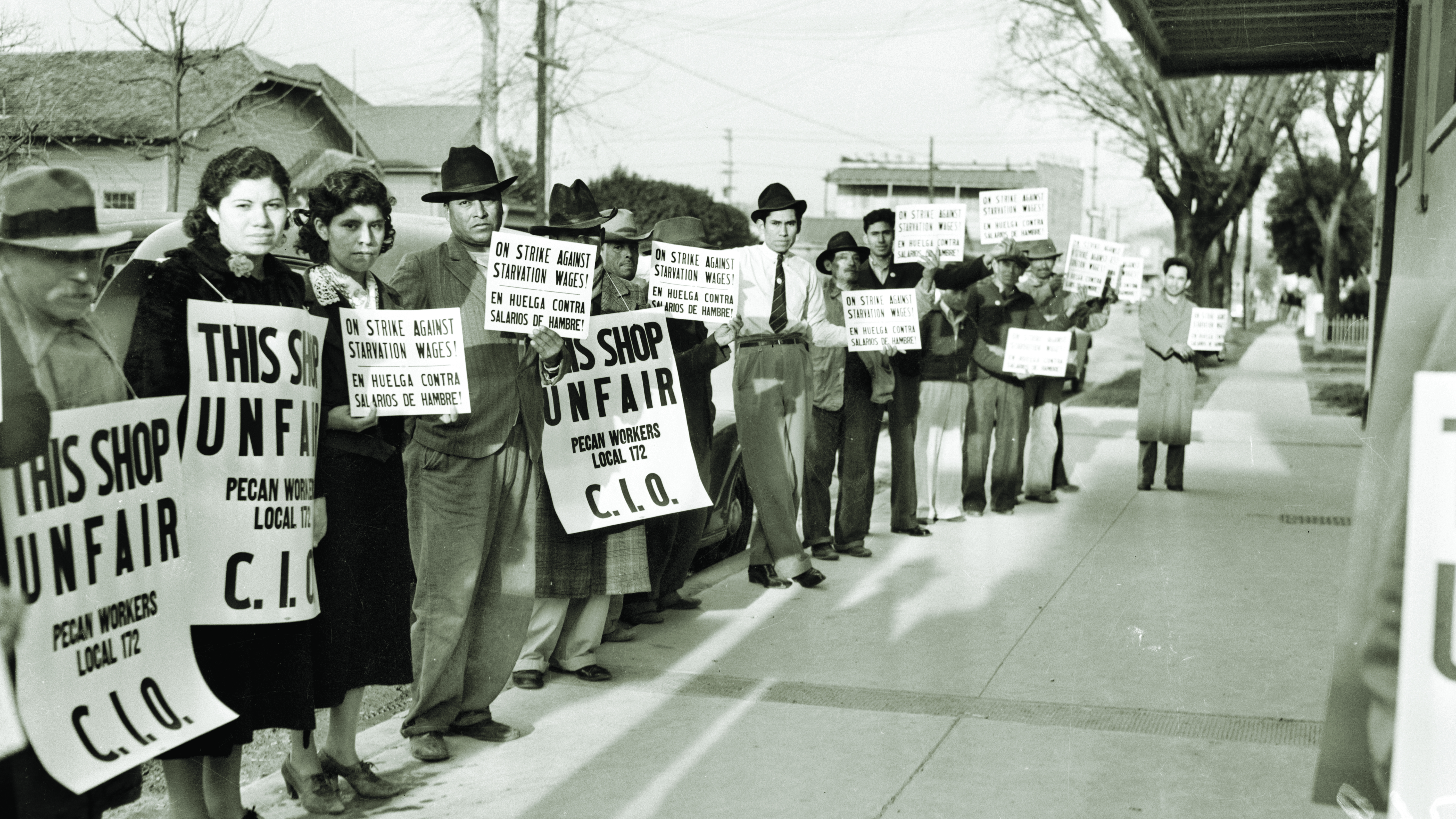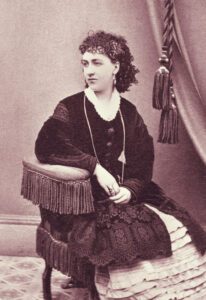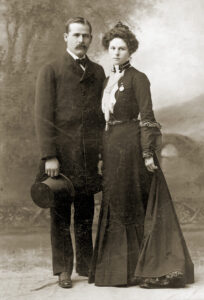Mexican-Americans’ brave stand against city politicians, the Catholic Church, and the police changed labor history
ON JANUARY 31, 1938, a wildcat walkout by thousands of Latino workers, mostly women, rocked the West Side of San Antonio, Texas. In that barrio, where many families depended on seasonal work shelling pecans to get through the winter, shellers set down their rudimentary tools at hundreds of shabby, overcrowded factories and took to the streets. The action came in response to an immediate and unilateral 20 percent cut in shellers’ already skeletal wages by the region’s dominant pecan distributor. The ensuing confrontation, which establishment San Antonio blamed on communist-inspired outside agitators, actually had arisen from local frustration with wages, working conditions, and harsh bias that characterized treatment of Latinos in that region and era. The strike came at a hinge moment for the pecan industry and workers’ gains proved fleeting, but for Mexican-Americans living in San Antonio and vicinity the action has continued to resound.
[divider_flat]The mention of Depression-era American labor strife usually summons images of skilled craftsmen in northern cities unionizing to force industrial behemoths to raise wages and improve working conditions, not of unskilled, marginalized minorities and residents of Southern states organizing successfully to improve their lot. That 1938 strike in San Antonio by just such workers evolved into one of the most important labor events in Texas and American history.
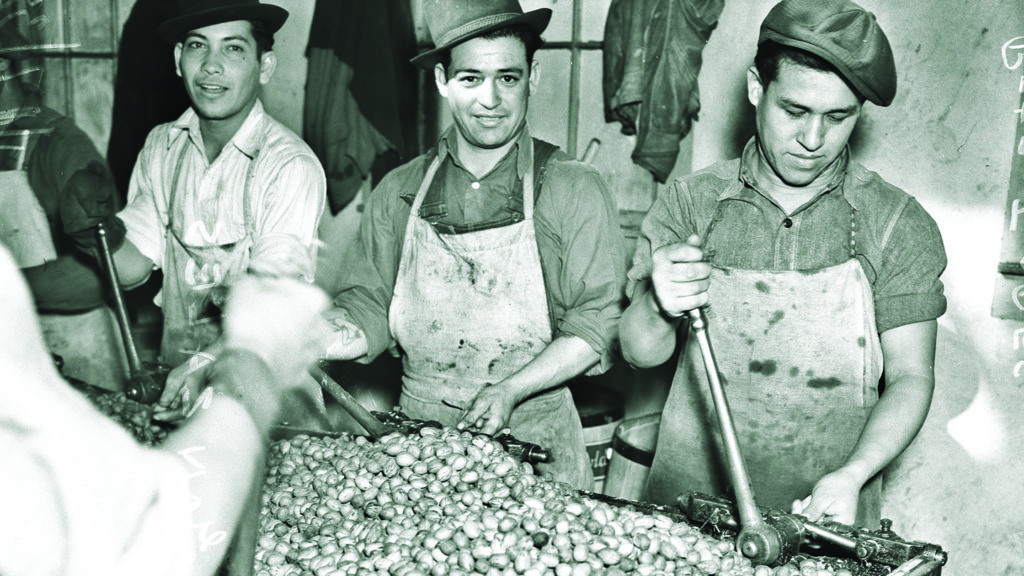
Surrounded for hundreds of miles by pecan groves, San Antonio was the historic center of the Texas pecan market, which was the centerpiece of the American market for the nuts. Based on harvests from native trees along the rivers of Central and South Texas, the state led the nation in pecan production. Commercial pecan marketing began in the late 1800s, when Swiss-born candy maker and baker Alfred Duerler began shipping shelled nuts to markets in the Northeast. In 1919 Texas named the pecan its state tree. By the 1920s, San Antonio was processing most of the pecans grown in Texas.
Harvest and shelling season was between November and March. In those pre-hybridization days, pecans had stiff woody shells about 1/8” thick. Whole pecan meats, packaged while still fresh, brought the best prices, adding urgency to the task of processing. But cracking a nut without damaging the meat was no simple task. Originally Duerler’s workers cracked nut shells with railroad spikes, after which young Latinas picked free the nut meats using heavy curved needles intended for sewing burlap. When a mechanical cracking machine debuted in 1889, Duerler adopted it; in 1914, crackers began to be electrified. By the 1920s, power crackers were standard. Channels fed nuts by size to a breaker. That device applied enough pressure to shatter the shell without harming the meat, which still had to be separated from the shell’s soft interior. Young Latinas picked nut meat by hand.
In 1926, bucking a nationwide trend toward automation, Julius Seligmann and Joe Freeman founded Southern Pecan Shelling Company. Their outfit’s picking line was manual, with men doing the cracking and women the shelling. Enterprising crackers used a purpose-built tool—a wooden handle with metal teeth at its business end and a short spike on one side. Pressing the teeth against the shell, a worker gave a quick twist to crack the nut, then with the spike loosened the meat. But most shellers improvised, adapting whatever was handy, like cobblers’ needles intended for stitching leather. The goal, not always reached, was to extract two intact nut halves. A picker working a 51-hour week and paid by the pound earned a little more than $2.
By the 1930s, half the nation’s shelled pecans were coming from San Antonio. Southern Pecan was handling about half the Texas crop and shelling about 40 percent of pecans sold in the United States. In 1939, the U.S. Labor Department reported that during 1935-36 Southern Pecan profits exceeded $500,000—today, $9 million-plus. By avoiding outlays for machines and subcontracting shelling under tight controls, the company had built a monopoly. Contractors bought whole pecans from Southern Pecan and sold cleaned nut meat to Southern Pecan at a scant profit. Besides setting prices, Southern Pecan dictated wages and other parameters, blacklisting contractors who strayed.
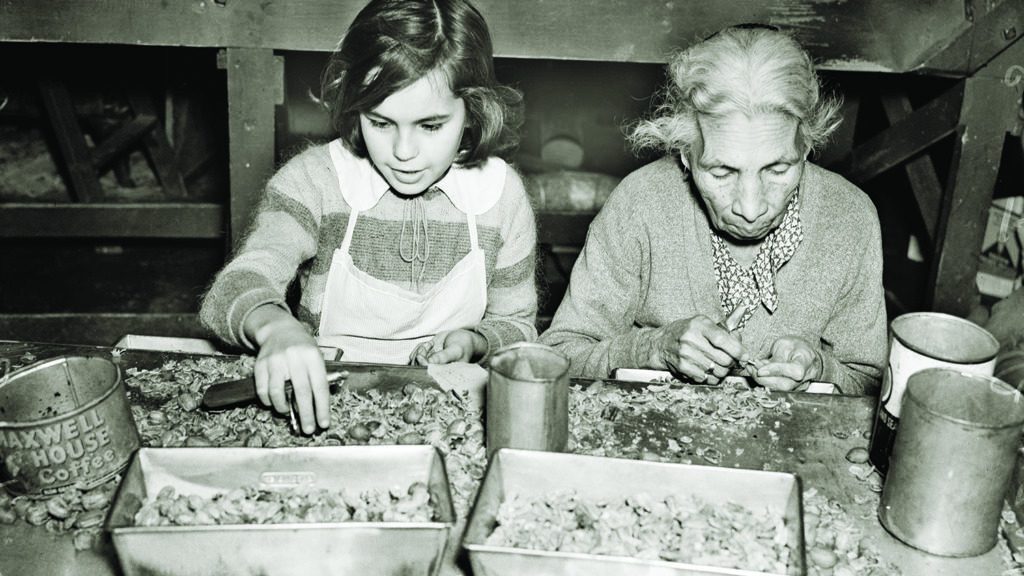
Pecans were not a pillar of the local economy, but for the city’s poorest Latino residents, most of whom lived on the West Side, nut processing was a key source of income, earned seasonally in rough sheds optimistically labeled “factories.” In the early 1930s, the West Side counted some 400 pecan factories that at season’s height employed as many as 20,000 workers. A few families shelled at home, with all hands cracking nuts, but most shelling took place in ramshackle buildings around the barrio, home to mostly impoverished Mexican citizens and Tejanos who wintered there between stints as migrant cotton and sugar beet harvesters.
The West Side barrio, four miles square, was among the country’s worst slums—Audrey Granneberg, in Survey Graphic, characterized housing there as “floorless shacks renting at $2 to $8 per month…crowded together in crazy fashion on nearly every lot. They are mostly without plumbing, sewage connections or electric lights. Open, shallow wells are often situated only a few feet away from unsanitary privies. Streets and sidewalks are unpaved and become slimy mudholes in rainy weather.”
Nearly 80 percent of West Side households had only kerosene lamps for lighting; a higher percentage cooked over open fires, subsisting mainly on tortillas and beans. Fewer than 20 percent of barrio homes had access to potable water, and only about 10 percent had indoor plumbing. In some blocks, 50 families shared a single outhouse. Scarcity of running water discouraged bathing and handwashing, multiplying health problems. The neighborhood was rife with malnutrition and tuberculosis, and infant mortality. High unemployment, racism, and wage discrimination complicated these factors. In addition to competition for jobs from a constant stream of new immigrants, resident migrant agricultural workers returned each winter to their homes on the west side, ballooning the unemployment rate.
Historically, two industries in the barrio hired low-skill Latinas: Frick Cigars and a cluster of garment shops. Both paid better than pecan shelling. Early in the Depression, San Antonio cigar and garment workers tried to organize, gaining minor benefits amid fierce suppression by city police. San Antonio native Emma Tenayuca emerged from these efforts as a strong, audacious leader. Adept at public speaking and organizing, Tenayuca was 16 in 1933 when she joined the women striking Frick Cigars for better wages, improved working conditions, and recognition of their union. Arrested and jailed, Tenayuca stood firm, a year later helping to organize a garment workers’ strike. Tenayuca took up other causes, joining an umbrella entity, the Workers’ Alliance, organized to fight low wages, ethnic and gender discrimination in wages, and cuts to Works Progress Administration relief rolls. Among Tenayuca’s campaigns were efforts to obtain government-funded clothing, school supplies, and free lunches for children whose parents were on relief. In 1937, Tenayuca joined the Communist Party, less out of its internationalist ideology than for the practical reason that “no one else but the communists expressed any interest in helping San Antonio’s dispossessed Mexicans,” according to historian Zaragosa Vargas.
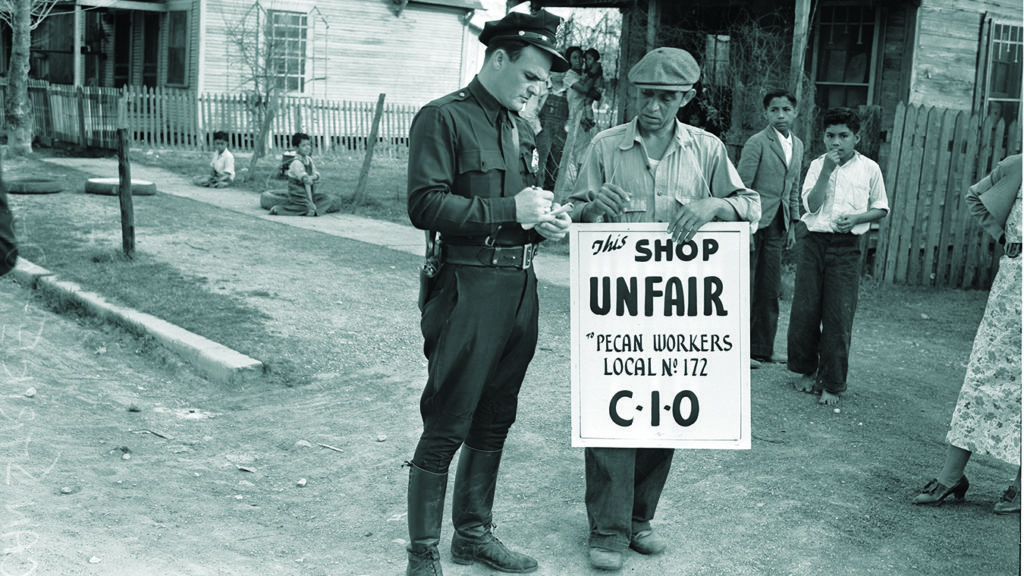
Pecan shelling not only paid less than rolling cigars and sewing but subjected workers to harsher conditions. Shellers sat elbow-to-elbow on unpadded backless benches 8 to 10 hours per day—it was not unusual for 100 people to cram a room 25×40 feet—working in dim light from windows opened only in good weather. Shellers were “packed wall to wall, shoulder to shoulder with people sitting at benches to shell the pecans—old people, young people, children from the earliest age, sick people, well people, bad people, good people,” a man who had shelled pecans as a boy told historian Matthew Keyworth. “Whole families…worked there 10, 12, 14 hours daily to together bring home enough to keep body and soul together.” Shelling generated a fine brown dust that filled the factory air and entered workers’ lungs, exacerbating already rampant asthma and tuberculosis. Until 1936, when San Antonio mandated installation of running water and indoor toilets, most factories lacked those facilities, and even after the regulation took effect had only one toilet for all workers. Shell splinters caused cuts and infections.
Shellers earned a piece rate, gauged by weight and quality. Intact pecan halves paid more than “pieces,” or fragments of halves that broke. Fragments had to be of a certain size to count. Averaging 8-9 lb. of pecan meats per day at 6 to 7 cents per lb., a family of four earned about $192 per year. Fulltime workers averaged $2.50 weekly, and the typical two-worker family unit averaged about 69 cents a day, according to a government study. Labor Department data showed that from September 1 to December 31, 1937, the highest-paid Southern Pecan workers averaged less than $3 a week. In 1938, unskilled male industrial workers averaged $15 to $20 a week. In season, shellers put in at least six 9-to-10-hour days a week, but that was only late November through March. Most relied on municipal relief to survive.
During the San Antonio winter, shelling was all the work there was—an ill-paid and grueling necessity, and, until the Depression clamped down, the province of women and a few elderly or disabled men. The worsening economy forced able-bodied men onto the shelling benches—for many, a humiliating experience, said Alberta Snid, who shelled pecans as a child. “Men had to come in and sit next to the family to do the work,” said Snid. “You take, for example, my father—I think that as a last resort he had to go in and shell pecans. He was a very proud man, but he had to leave his pride behind him and to go in there and sit next to us to earn a living because there was nothing else.”
Access to this captive winter labor force was why, unlike pecan wholesalers elsewhere, Seligmann decided in 1926 to forgo modernizing his production lines. The company’s shellers occasionally protested conditions and pay, and in the early 1930s tried twice to organize in campaigns cut short by fierce resistance from Southern Pecan and San Antonio officials. In November 1937, the new Congress of Industrial Organizations chartered the Texas Pecan Shelling Workers Union, led by Albert Gonsen. In San Antonio, members of that union formed Local 172. Soon one of the most important labor conflicts in Texas history had gotten under way.
On Monday, January 31, 1938, Southern Pecan contractors, at Julius Seligmann’s direction, cut the rate paid shellers per pound for pieces and halves from 6 and 7 cents, respectively, to 5 and 6 cents, reducing a punitively low wage by nearly 20 percent. As soon as word of this spread, thousands of shellers spontaneously walked off the job in. Statewide shelling workers organizer Gonsen at first hesitated to involve his union, but as more shellers hit the bricks, Local 172 joined the wildcat strike.
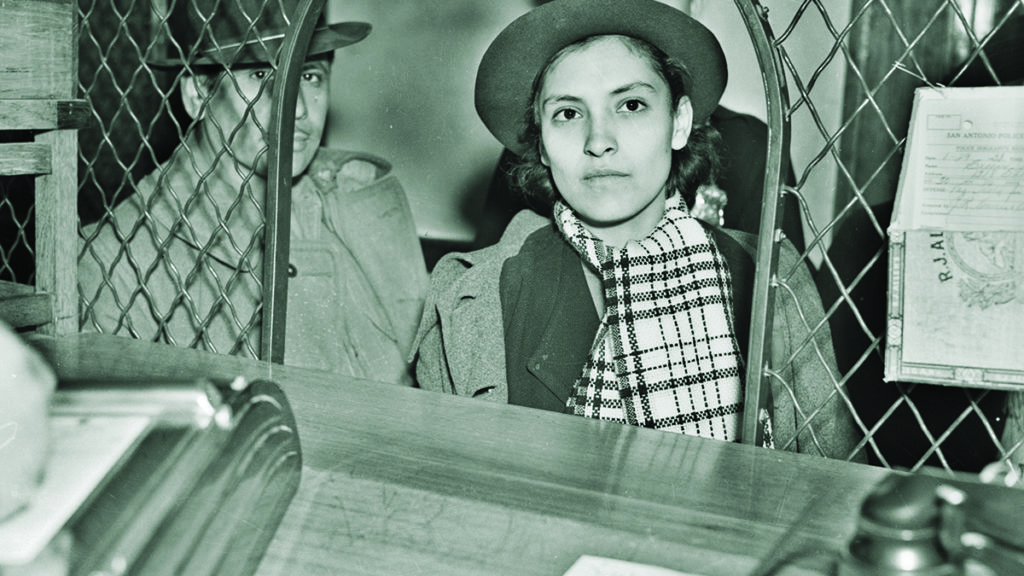
Strikers not only were protesting pay cuts, but also seeking union recognition and the right to bargain collectively on their own behalf. They demanded factories restore wage rates pending arbitration. By mid-February at 130 West Side plants, over half the shellers, mostly women, were on strike and had joined Local 172, according to the San Antonio Express. Emma Tenayuca, now 22, was elected as a primary leader. She allied with fellow activists Maria Solis Sager, Minnie Rendon, and others. Tenayuca’s youth was no hindrance, but to avoid red-baiting over her Communist Party history the national union leadership muzzled her. Even so, many strikers continued to look to her for direction. Don Henderson, president of the national union, arrived in San Antonio. He named J. Austin Beasley, an experienced CIO organizer with no communist ties, to run the strike. Beasley headed the all-male strike committee, with Tenayuca staging daily meetings, writing and distributing circulars, and encouraging strikers by getting food to their families. Arrested on charges of communist agitation, she spent time in the Bexar County jail. Across the West Side workers, many carrying placards reading “This Shop Unfair Pecan Workers Local 172 CIO,” were picketing pecan factories.
Opposing the strike were San Antonio’s civic pillars: the Democratic political machine and police, the Roman Catholic hierarchy, and the press. The Mexican American Chamber of Commerce and the local chapter of the League of United Latin American Citizens disavowed the strike. Official statements attempted to downplay the action’s size and impact. The city blamed “outside agitators” for whipping up the citizenry. Mayor C. K. Quin and his police department went after strikers legally and illegally. Officers teargassed, whipped, and clubbed strikers. Claiming to be enforcing a law requiring the city marshal, an office that no longer existed, to approve advertisements, police declared picketers’ signs illegal, arresting those carrying placards and destroying the signs. Police officers entered homes to threaten strikers with arrest or deportation unless they returned to the shelling bench. Officers harassed and arrested men and women, young and old, able and disabled. The city deputized municipal firefighters armed with clubs to assist them.
In the course of six weeks, city authorities arrested more than 1,000 people on charges of blocking sidewalks, carrying signs without permits, assembling unlawfully, and the like. Police sometimes crammed 30 prisoners into a cell designed to hold four, turning firehoses on those who protested. When the Bexar County jail could hold no more, officers hauled arrested persons into the scrub outside of town and abandoned them. Jailed strikers could be heard at night singing Spanish-language verses to “Solidarity Forever” and “We Shall Not Be Moved.”
According to San Antonio Police Chief Owen Kilday, outsiders and “communists” were trying to stir insurrection on the West Side. Kilday said he would use any means to defeat the troublemakers—a stance a Labor Department official described as “a subterfuge.” Incidence of strike-related violence was “almost entirely instigated by San Antonio’s law enforcement establishment,” historian John Weber said.
San Antonio’s Health Department, historically active at best only marginally on the West Side, closed municipal soup kitchens frequented by strikers. The city’s Catholic leadership, including Archbishop Jerome Drossaerts, condemned the strike as communist-led. Local newspapers sided mostly with the authorities, in editorials pooh-poohing the action’s significance and condemning unions and workers for undertaking the action. In spite of or because of such establishment resistance, the protest grew, attracting attention outside San Antonio that came to focus on police abuse.
In February, Texas Governor James Allred asked the State Industrial Commission to investigate. Mayor Quin locked state investigators out of city offices; Bexar County gave them working space in the courthouse. Two days of testimony from both sides led the panel to conclude unanimously that the police had no basis for their violent behavior and that the strikers were raising legitimate issues. The commission specifically objected to police refusal to permit peaceful assembly in locations hired for that purpose, forcible return of workers to the shelling bench under threat of arrest, and destruction of union signs and buttons. City leaders ignored the report.
Coverage of and protests about the situation spread. CIO organizer George Lambert described how city police actions attracted the notice of Mexican government officials when police clubbed a 60-year-old woman carrying her grandchild past a West Side shelling factory.
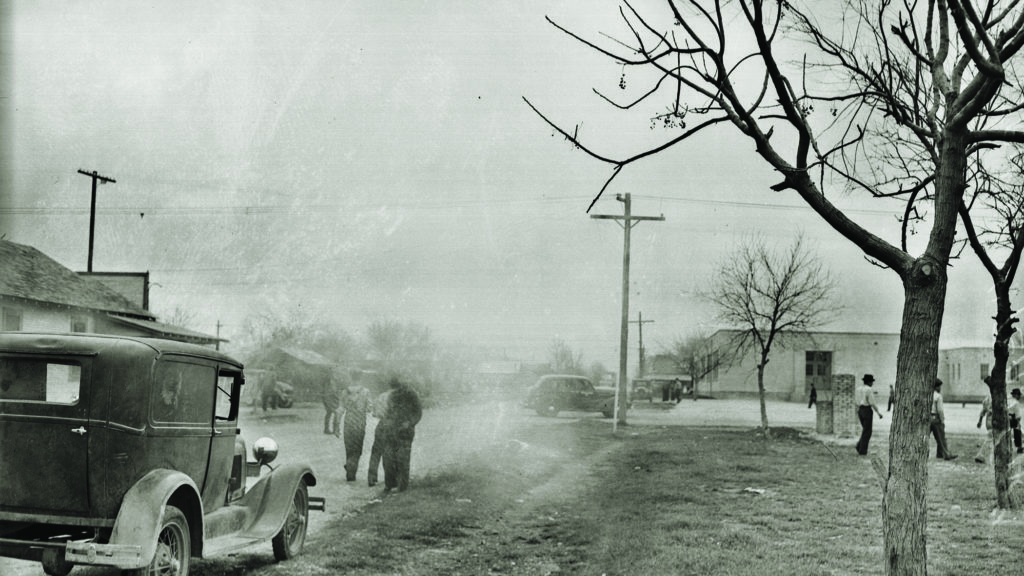
The woman who was beaten, a citizen of Mexico, was not even a striker; she was on her way to buy groceries. Mexican diplomats protested this and other strike-related incidents to the U.S. State Department, the first time a foreign government had registered such a complaint against an American city’s police. The San Antonio Light reported that the Mexican consul contacted Governor Allred on behalf of the Mexican government to protest the arrest in San Antonio of 63 Mexican citizens.
Learning of shellers’ wretched pay while in town, Labor Secretary Frances Perkins asked publicly, “Do you in San Antonio call that wages?” Time and other national periodicals covered the strike. Prominent San Antonio residents, including members of the Women’s International League of Peace and Freedom led by Cassie Winfree and Minnie Rendon, investigated jailers’ treatment of female strikers, and based on their findings of abuse leveled a protest of their own. The League also sought permission to provide food and supplies to the strikers.
Caustic radio and newspaper coverage, pressure from Governor Allred, and the strikers’ own resilience forced the city and Southern Pecan to accept arbitration. On March 9, 1938, slightly more than five weeks after the wildcat walkout, Seligmann agreed to recognize International Pecan Workers Local 172 as the sole bargaining agent for San Antonio shellers. Pending arbitration, workers returned to the benches.
Arbitrators reset the shellers’ wage at 5½ and 6½ cents per pound of pieces and halves from June 1 to November 1, 1938, when the rate would return to the pre-strike level of 6 and 7 cents per pound. As November 1 neared, Congress enacted the Fair Labor Standards Act, stipulating a national minimum wage of 25 cents per hour. This was more than triple the arbitrated shelling wage, making hand shelling much more expensive than automated shelling. Southern Pecan tried and failed to obtain an exemption from the minimum wage. The company installed shelling machines. By March 1939, Southern Pecan was employing only 1,800 workers; by 1941, those ranks had shrunk to 600. Around 10,000 workers lost their seasonal jobs, and Pecan Shellers Local 172 withered to nothing.
Despite the long-term negatives, many observers thought the action a victory because it engendered solidarity and cultural identification. “The pecan shellers strike was about more than wages. Those who remember it do not talk of the wage increase or even of the workers who ultimately and permanently lost jobs in the industry,” attorney Emily Jones wrote in a 1991 paper, “Ya Basta! The San Antonio Pecan Shellers’ Strike of 1938.” “They remember a mass movement, and the common comparison is to the civil rights marches of the 1960s.”
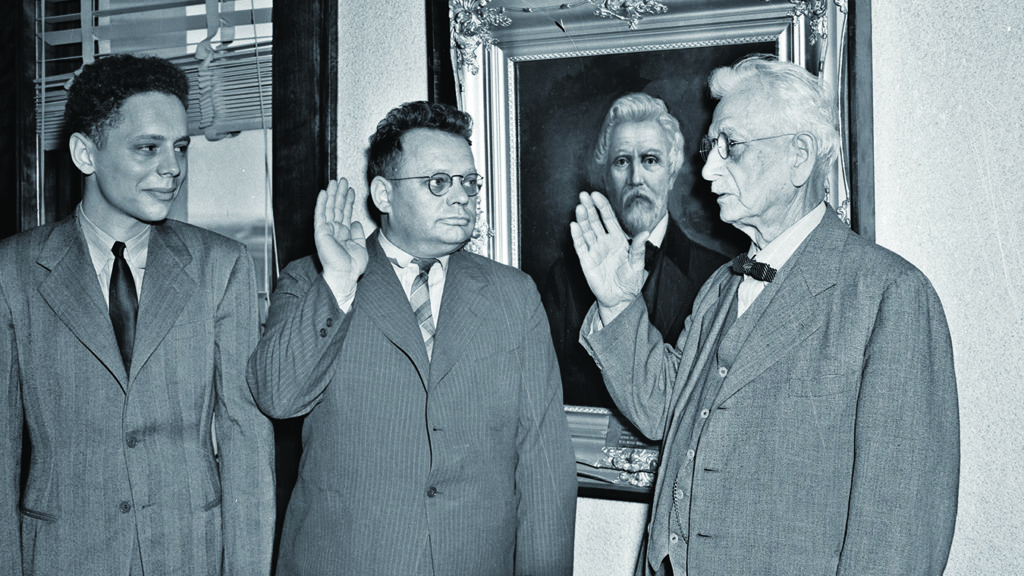
West Siders’ changed political attitudes remade San Antonio politics. The old equation of poll tax payment in exchange for a vote and bloc voting to the machine’s whim evaporated. No longer were Latino citizens willing to sell their votes to the bosses, and for a time the dominant political machine lost traction. The 1939 San Antonio mayoral election saw incumbent Quin, the bosses’ pick, oppose progressive Maury Maverick. Campaigning vigorously on the West Side, Maverick garnered many votes there, in the process seeing his surname come to mean a disruptive upstart. Maverick beat Quin and as mayor 1939-41 he improved conditions in the West Side. During his one term Maverick did much to honor the city’s Mexican heritage.
Blacklisted, Emma Tenayuca was run out of San Antonio. In San Francisco, California, she studied education at San Francisco State College, returning to San Antonio for a master’s degree, spending her career teaching in her hometown’s Harlandale School District. She retired in 1982 and died in 1999.
The pecan sheller strike empowered a community previously mired in passivity. “We learned that through organization we could do something,” striker Alberta Snid told an interviewer. “Maybe we didn’t win that much as far as money was concerned, but we learned that being united is power…we forgot a little bit of the fear that we had, because before we couldn’t say nothing, we couldn’t talk, period. Afterwards it was entirely different.”
Some changes came and went. In 1941, accusations of communist fellow travelerdom got Maverick booted from office. The barrio stayed poor. Most pecan shelling jobs vanished. But many former strikers recalled with great pride their days standing up to the city machine and to Southern Pecan, and most held onto the sense of community and dignity arising from that action. Emma Tenayuca is celebrated as a hero of Latino civil rights in Texas, remembered primarily for her stand on behalf of the shellers and other dispossessed Tejanos in Depression-era San Antonio.

